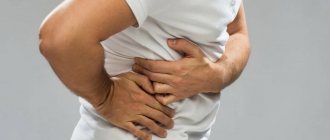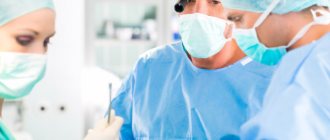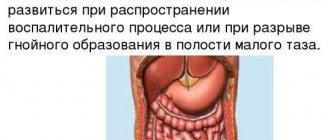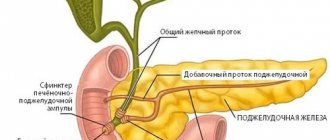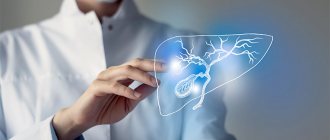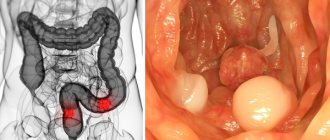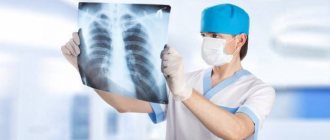When a patient first consults a specialist about biliary colic, this does not mean that an acute pathological process is already underway in the body. Most often, the examination results determine chronic cholecystitis, the treatment of which takes quite a long time.
Symptoms of cholecystitis develop gradually, so often an attack of biliary colic is an exacerbation of the chronic form of a latent gallbladder disease.
In most cases, chronic cholecystitis manifests itself:
- pain in the right hypochondrium;
- decreased appetite;
- bitterness in the mouth;
- nausea, less often - morning vomiting of bile.
During exacerbations of the disease, attacks of cutting pain in the epigastric region or in the right hypochondrium are observed.
The pain can radiate upward and to the right - to the area of the right shoulder blade, right shoulder, right half of the neck. In some cases, pain spreads throughout the abdomen, intensifying when lying on the left side and taking deep breaths.
Causes of the disease
Although biliary colic is closely related to cholelithiasis, other diseases can also provoke its appearance. So:
- In children and adolescents, this pathology often occurs against the background of functional disorders. Mainly - with biliary dyskinesia of the hypertensive type. In such cases, the pain attack is minor and does not last long. As a rule, it goes away on its own, without medication.
- Giardia is considered another cause of hepatic colic. These single-celled parasites enter the intestines along with food, causing inflammation of the bile ducts and their blockage. The effectiveness of treatment depends on how quickly giardiasis is detected. Duodenal intubation and bile culture are used to detect parasites.
- In adult patients, the cause of the development of pathology is often a stone in the gallbladder or common bile duct (choledochus). Driven by bile flows, it clogs the lumen, causing the smooth muscles to begin spasmodic contraction, and the patient experiences pain.
- Today, hepatic colic is increasingly developing against the background of congenital narrowing or deformation of the ducts. In such a situation, only surgical intervention (preferably) or prolonged treatment of the pathology with conservative methods can help. Ultrasound examination helps diagnose the presence of deformities.
Additional signs of the disease
In addition to pain, there is a feeling of nausea, and vomiting with bile may occur, which does not bring relief to the patient. The skin becomes jaundiced or pale. A brown-yellow coating appears on the tongue, the patient complains of dry mouth.
In the upper right part of the abdominal wall there is limited mobility, it is painful on palpation, and skin sensitivity is increased.
It is important to understand that the localization of pain in the right shoulder blade and the right half of the chest is typical not only for diseases of the gallbladder, but also for a number of other pathological conditions of the body. That is why it is extremely important to find out the cause of the pain attack. With cholecystitis, pain most often appears after eating fatty foods and other foods that are difficult to digest. A relapse of an attack is most often associated with mental trauma, nervous strain or stress.
In patients with gallstone disease, an attack often occurs due to physical stress and fatigue, for example, after cycling or going to the gym.
If transient jaundice develops after an attack, this may be a symptom of both hypermotor dyskinesia and cholelithiasis. In some cases, when the outflow of bile is impaired, patients experience discolored gray-white feces for several days.
A painful attack in uncomplicated gallstone disease begins suddenly and also ends suddenly. The very next day the patient feels satisfactory.
Symptoms of pathology
The medical term “colic” is described as “sharp, frequently recurring, cramping pain. The occurrence of this condition is caused by an involuntary muscle spasm. Therefore, the surest sign of the presence of hepatic colic is private pain in the right hypochondrium. However, sometimes they radiate to other areas:
- Right scapula – with obstruction of the common bile/cystic duct.
- Various areas of the chest and abdomen - with slow recirculation of bile acids.
- Back – during prolonged attacks lasting more than 5 hours.
Those who:
- Does not tolerate fatty foods well or does not tolerate them at all.
- Constantly experiences pain of the same intensity.
- Feels painful discomfort with sudden movements.
- Suffers from periodic pain in the liver area, and attacks last from 15 minutes to 5 hours.
- Cannot work in an inclined position.
- Suffering from (at first glance) causeless vomiting.
Causes of pain in the gallbladder
Pregnancy
The appearance of pain and discomfort in the gallbladder area is due to the development of cholestasis in pregnancy. Symptoms occur in the 3rd trimester of pregnancy and disappear in the first days of the postpartum period. Pain is caused by stagnation of bile in the biliary tract (BDT). In addition to pain, yellowness of the skin and mucous membranes and severe itching are noted. The urine becomes dark in color and the stool becomes gray.
Biliary dyskinesia
Functional disorders, which include gallstones, are the most common cause of pain in the gallbladder in children, young and middle-aged people. The nature and duration of the pain syndrome is determined by the type of motor impairment. With the hypermotor variant, the pain is cramping, strong, reminiscent of biliary colic. They appear 20-30 minutes after finishing a meal. Pain is often caused by psycho-emotional stress.
With the hypomotor variant of dyskinesia, aching or nagging pain in the right hypochondrium is disturbing. It begins 40-90 minutes after eating and is provoked by fatty foods and alcohol consumption. In contrast to hypermotor JP, the pain syndrome is longer lasting - up to several hours. It is accompanied by nausea, vomiting, a feeling of heaviness in the abdomen, alternating constipation and diarrhea.
Chronic cholecystitis
With this pathology, periodic pain is observed, localized on the right in the hypochondrium. They are provoked by eating large amounts of fatty foods, which leads to increased secretion of bile and increased load on the gallbladder. In women, symptoms worsen before menstruation. In chronic cholecystitis, the pain is dull or aching, not intense, combined with bitterness in the mouth, nausea, and stool instability.
Acute purulent cholecystitis
This disease is characterized by severe cramping pain in the gallbladder area that appears suddenly. To alleviate the condition, a person lies on his side and pulls his knees towards his stomach. A painful attack is accompanied by fever, sweating, and tachycardia. When inflammation passes into empyema of the gallbladder, pain reaches maximum intensity, body temperature rises to 40°C.
Cholangitis
In the acute form of inflammation of the bile ducts, sharp, severe pain is observed in the right hypochondrium. For them, irradiation is specific to the right shoulder, neck, and interscapular region. The symptom appears suddenly in combination with febrile fever and jaundice. There is no clear connection between pain and dietary errors or other typical factors. At the same time, nausea and vomiting, diarrhea, and weakness occur.
Chronic cholangitis is characterized by aching pain in the projection of the gallbladder. They are felt periodically, accompanied by heaviness in the hypochondrium on the right and a feeling of fullness in the epigastrium. The pain syndrome is not intense and does not require analgesics. In most cases, the pain disappears on its own after a few hours. The addition of general symptoms is typical: prolonged low-grade fever, increased fatigue.
Cholelithiasis
Pain syndrome is the main manifestation of the disease. A typical attack of cholelithiasis is called biliary colic. It develops with the abuse of fatty foods and emotional experiences. Suddenly, intense pain appears above the gallbladder and in the epigastrium. It radiates to the scapula, lower back, and precordial region. Often the pain is so strong that the person rushes about in bed and cannot find a position in which the pain subsides.
The attack lasts several hours. The pain is cramping in nature and is not relieved by conventional analgesics. For cholelithiasis, it is typical to increase body temperature simultaneously with the onset of pain. Clinical symptoms are supplemented by severe nausea and vomiting, and stool disorders. Chills and pale skin are noted.
Parasitic infestations
Pain in the right hypochondrium can be a sign of giardiasis. With this pathology, a mild pain syndrome is observed. There is no connection between pain and diet disorders or physical overexertion. The symptom is combined with unstable bowel movements, flatulence, and nausea. With parasitic infections, intoxication syndrome is also pronounced.
Postcholecystectomy syndrome
Symptoms of the disease occur after surgery to remove the gallbladder. Postcholecystectomy syndrome is characterized by recurrent pain attacks that develop for no apparent reason. The pain has a different character - cutting, spastic, dull, aching. The pain is accompanied by dyspeptic symptoms: belching, bitterness in the mouth, nausea, bloating. Diarrhea occurs with copious foul-smelling feces.
Gallbladder tumors
Benign polyps of the organ are characterized by scant symptoms. Periodically, dull pain is felt at the location of the gallbladder, which is not associated with food intake. In a small number of patients, the disease manifests itself as sharp pain and spasms in the right hypochondrium, which are provoked by eating fatty foods or physical activity.
In case of gallbladder cancer, pain syndrome is expressed at an advanced stage. There is a mild dull pain over the organ, which appears for no apparent reason. At first it bothers you sporadically, and then it becomes constant. The clinical picture is characterized by a progressive decrease in body weight, lack of appetite, and prolonged low-grade fever.
Consequences of hepatic colic
The interval between relapses of painful attacks is often calculated in months, or even years. Because of this, many patients do not attach due importance to this pathology and do not seek medical help. As a result, this results in a whole bunch of diseases:
- Non-calculous, acute or emphysematous cholecystitis.
- Reactive pancreatitis.
- Hydrocele of the gallbladder.
- Cholangitis.
- Empyema (excessive purulent accumulation inside the affected organ).
- Perforation of the gallbladder.
- Gastric fistulas.
- Intestinal obstruction caused by the formation of gallstones.
If your gallbladder hurts, what should you do?
If pain or discomfort appears in the area of the right hypochondrium, which is accompanied by bitterness in the mouth, and intensifies after consuming fatty, fried foods or alcohol, one should suspect the development of a pathological reaction of the structures of the hepatobiliary system. In this case, first of all, you need to consult a specialist doctor. Based on the data obtained from the clinical study, he will conduct further additional examination, including ultrasound diagnostics, laboratory analysis of bile, and duodenal intubation.
Using modern diagnostic techniques, the SKZD clinic in Rostov-on-Don determines the location, chemical and physical characteristics of the stone, which makes it possible to choose further optimal treatment tactics. In most cases, once a stone is discovered, it is removed through surgery. Laparoscopic procedure or laser evaporation. The doctor selects the removal technique on an individual basis, depending on the size, number of stones, their location, age and general condition of the patient.
Diagnosis and treatment
The symptoms of hepatic colic are similar to those of a number of other diseases. Therefore, an accurate diagnosis can be made only after the patient undergoes radiography and ultrasound examination of the liver and gallbladder.
Pain relief is achieved by taking antispasmodics and analgesics. Patients often combine it with the application of heat to the painful area of the body. And sometimes they try to get rid of pain with the help of choleretic drugs. If all this happens without the supervision of a doctor, the result is usually disastrous. Ordinary people do not have sufficient knowledge and experience to accurately diagnose the disease. And by self-medicating, they only put their body at risk.
It is necessary to combat hepatic colic and related diseases in a comprehensive manner. Medical gastroenterologists are ready to help you. Our specialists are leading practicing doctors in the Moscow region. They will quickly identify the disease and help neutralize it. For the convenience of patients, online registration is used. A flexible system of discounts is provided for regular clients of the clinic and patients from various social groups.
Acute cholecystitis - symptoms and treatment
Patients with acute cholecystitis are subject to emergency hospitalization in the surgical department of the hospital. After carrying out the necessary diagnostic measures, further treatment tactics are determined. In the presence of severe complications - perivesical abscess, destructive cholecystitis with peritonitis - patients are subject to emergency surgery after short-term preoperative preparation.[1]
Preparation consists of restoring the volume of circulating blood, detoxification therapy by infusion of crystalloid solutions in a volume of 2-3 liters. If necessary, correction of cardiac and respiratory failure is carried out. Perioperative antibiotic prophylaxis is performed (before, during and after surgery).
The surgical approach is selected depending on the technical capabilities of the clinic, the individual characteristics of the patient and the qualifications of the surgeon. The most commonly used is the laparoscopic approach, which is the least traumatic and allows for full inspection and sanitation.[12]
The mini-access is not inferior to the laparoscopic approach in terms of morbidity and has the advantage of eliminating the need to apply pneumoperitoneum (limit the mobility of the diaphragm).[10] If technical difficulties arise, severe adhesions in the abdominal cavity and diffuse peritonitis, it is more advisable to use a laparotomic approach: upper midline laparotomy, Kocher, Fedorov, Rio Branca access. In this case, the upper midline laparotomy is less traumatic, since in this case the muscles are not intersected, however, with oblique subcostal approaches, the subhepatic space is more adequately opened for surgical intervention.
The operation consists of performing a cholecystectomy. It should be noted that the presence of perivesical infiltrate implies certain technical difficulties in mobilizing the neck of the gallbladder. This leads to an increased risk of damage to elements of the hepatoduodenal ligament.[13] In this regard, one should not forget about the possibility of performing cholecystectomy from the fundus, which allows for more clear identification of the elements of the cervix.[16]
There is also the “Pribrama” operation, which consists of removing the anterior (lower) wall of the gallbladder, suturing the cystic duct in the neck area and mucoclasia (removal of the mucous membrane) by electrocoagulation of the posterior (upper) wall. Performing this operation with a pronounced infiltrate in the area of the bladder neck will avoid the risk of iatrogenic damage. It is applicable for both laparotomic and laparoscopic approaches.
If there are no severe complications of acute cholecystitis, then upon admission of the patient to the hospital, conservative therapy , aimed at unblocking the gallbladder. Antispasmodics, anticholinergics, infusion therapy are used to relieve intoxication, and antibiotics are prescribed.
An effective method is to block the round ligament of the liver with a solution of novocaine. The blockade can be performed either blindly using a special technique, or under the control of a laparoscope when performing diagnostic laparoscopy and under ultrasound guidance.
If conservative therapy is ineffective within 24 hours, the question of radical surgery—cholecystectomy—is raised.
Of no small importance for determining treatment tactics is the time that has passed since the onset of the disease. If the interval is up to five days, then cholecystectomy is feasible; if it is more than five days, then it is better to adhere to the most conservative tactics in the absence of indications for emergency surgery. The fact is that in the early stages the perivesical infiltrate is still quite loose, it can be divided during surgery. Later, the infiltrate becomes dense, and attempts to separate it may result in complications. Of course, a period of five days is quite arbitrary.
If there is no effect from conservative treatment and there are contraindications for radical surgery - severe pathology of the cardiovascular and respiratory systems, five days have passed since the onset of the disease - it is better to resort to decompression of the gallbladder by applying cholecystostomy.[4]
Cholecystoma can be performed in three ways: from a mini-access, under laparoscopic control and under ultrasound control.[9] The most minimally traumatic procedure is to perform this operation under ultrasound guidance and local anesthesia.[3] Single and double punctures of the gallbladder with sanitation of its lumen under ultrasound guidance are also effective.[7] A necessary condition is the passage of the puncture channel through the liver tissue to prevent bile leakage.
After stopping the acute inflammatory process, radical surgery is performed in a cold period after three months. Usually this time is enough for the perivesical infiltrate to resolve.
